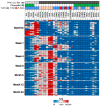Human Fecal Bile Acid Analysis after Investigational Microbiota-Based Live Biotherapeutic Delivery for Recurrent Clostridioides difficile Infection
- PMID: 36677428
- PMCID: PMC9865816
- DOI: 10.3390/microorganisms11010135
Human Fecal Bile Acid Analysis after Investigational Microbiota-Based Live Biotherapeutic Delivery for Recurrent Clostridioides difficile Infection
Abstract
Microbiome-based therapeutics are increasingly evaluated as a strategy to reduce recurrent Clostridioides difficile infection (rCDI), with proposed mechanisms including restoration of the microbiota and microbiota-mediated functions, such as bile acid (BA) metabolism. This study reports a quantitative and sensitive assay for targeted metabolomic assessment, and the application of the assay to profile BA composition in a Phase 2 trial of the investigational microbiota-based live biotherapeutic RBX2660 for reduction of rCDI. A liquid chromatography tandem mass spectrometry method was developed to extract and quantify 35 BAs from 113 participant stool samples from 27 RBX2660-treated rCDI participants in the double-blinded, placebo-controlled clinical trial. The results demonstrate a high-confidence assay as represented by sensitivity, linearity, accuracy, and precision. Furthermore, the assay enabled the observation of primary BAs as the dominant BA species at baseline in stool samples from clinical trial participants, consistent with the expected loss of commensals after broad-spectrum antibiotic treatment. After RBX2660 administration, there was a significant drop in primary BAs concurrent with increased secondary BAs that sustained through 24 months post-RBX2660. Taken together, we describe a robust assay that demonstrates altered BA metabolism in rCDI patients treated with RBX2660 administration.
Keywords: Clostridioides difficile; RBX2660; bile acids; dysbiosis; microbiota-based investigational therapeutic.
Conflict of interest statement
R.P., N.F., K.S., and B.C.F. are employees of Ferring Pharmaceuticals. K.B. is an employee of Rebiotix Inc., a Ferring company. C.G. and W.D.S. are employed by BioRankings, which received fees for this analysis from Rebiotix Inc., a Ferring company.
Figures





References
LinkOut - more resources
Full Text Sources

